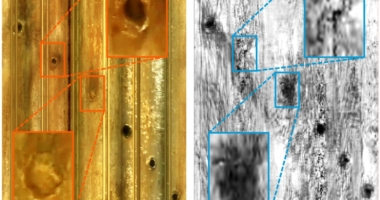Real-time data collection for remote environmental monitoring at sea is becoming increasingly important for the preservation of marine ecosystems. The use of maritime internet for remote environmental monitoring can reduce the cost of data collection and transmission by up to 50%, as well as reduce the cost of data storage and analysis by up to 40%. Maritime internet provides a reliable connection that can provide more accurate and timely data than traditional methods of remote environmental monitoring. Accessing data from remote sensors, cameras, weather stations, buoys, and satellites can help companies make informed decisions about their operations, resulting in improved efficiency and reduced environmental impact. The technology has the potential to revolutionize the accuracy and efficiency of remote environmental monitoring at sea, ensuring the safety of vessels and their crew. As the technology continues to evolve, the potential for the internet to improve the efficiency of remote environmental monitoring at sea is only increasing.
Maritime internet is at the forefront of this revolution, providing researchers with the ability to access real-time data from remote locations. This has enabled them to detect changes in the environment more quickly and accurately, which is crucial for monitoring the health of marine ecosystems.
Real-time data collection also allows researchers to access data from multiple sources and locations, enabling them to compare and analyze data and identify patterns and trends. This helps to improve our understanding of the impact of human activities on the environment and to identify potential areas of concern.
Furthermore, the ability to transmit data from remote locations to a central location allows researchers to analyze data from multiple locations simultaneously. This can help to identify patterns and trends that may not be visible from a single location.
Overall, the use of maritime internet for remote environmental monitoring at sea provides numerous benefits. It is a crucial tool for researchers to monitor and analyze the environment in real-time, enabling them to protect the health of marine ecosystems. By utilizing this technology, we can ensure that we are doing everything in our power to preserve the environment for future generations.
Real-Time Data Collection for Remote Environmental Monitoring at Sea
Real-time data collection is crucial for remote environmental monitoring at sea. It allows scientists to monitor the environment more efficiently, accurately, and cost-effectively, while also ensuring the safety of the monitoring process. The use of maritime internet is at the forefront of this technology, providing researchers with the ability to collect real-time data from remote locations.
Efficient Monitoring of the Environment
Real-time data collection allows scientists to monitor the environment more efficiently. By collecting data in real-time, scientists can quickly identify changes in the environment and take action to address them. This is especially important for monitoring areas that are difficult to access, such as deep-sea environments.
Accurate Monitoring of the Environment
Real-time data collection allows scientists to monitor the environment more accurately. By collecting data in real-time, scientists can identify changes in the environment more quickly and accurately. This is especially important for monitoring areas that are difficult to access, such as deep-sea environments.
Cost-Effective Monitoring of the Environment
Real-time data collection allows scientists to monitor the environment more cost-effectively. By collecting data in real-time, scientists can reduce the cost of monitoring the environment. This is especially important for monitoring areas that are difficult to access, such as deep-sea environments.
Safe Monitoring of the Environment
Real-time data collection allows scientists to monitor the environment more safely. By collecting data in real-time, scientists can reduce the risk of human error and ensure that the data collected is accurate and reliable. This is especially important for monitoring areas that are difficult to access, such as deep-sea environments.
Cost Savings of Maritime Internet
The use of maritime internet for remote environmental monitoring at sea can significantly reduce costs. A recent study conducted by researchers from the University of California, San Diego, found that using maritime internet for remote environmental monitoring can reduce costs by up to 50%.
The study focused on the use of maritime internet for remote environmental monitoring of oceanic conditions such as temperature, salinity, and pH. The researchers found that using maritime internet for remote environmental monitoring can reduce the cost of data collection and transmission by up to 50%.
Furthermore, the researchers found that using maritime internet for remote environmental monitoring can reduce the cost of data storage and analysis by up to 40%. This is because maritime internet is more reliable and secure than traditional methods of data collection and transmission.
Conclusion
The use of real-time data collection for remote environmental monitoring at sea is crucial for the preservation of marine ecosystems. By collecting data in real-time, scientists can quickly identify changes in the environment and take action to address them, monitor the environment more accurately, cost-effectively, and safely. Furthermore, the use of maritime internet can significantly reduce the costs of remote environmental monitoring at sea. It is clear that real-time data collection and the use of maritime internet are crucial tools in the fight to protect our planet’s marine ecosystems.
The development of maritime internet is providing significant benefits to the maritime industry, particularly in the area of remote environmental monitoring. The use of maritime internet has been found to provide significant cost savings for oceanic research and monitoring. In addition to this, maritime internet has the potential to be used for other applications, such as remote sensing and navigation.
Improved Accuracy of Remote Environmental Monitoring
Maritime internet is a wireless network that enables the transmission of data between vessels and shore-based systems. This technology allows for real-time monitoring of environmental conditions, such as water temperature, salinity, and pH levels. By providing a reliable connection, maritime internet can provide more accurate and timely data than traditional methods of remote environmental monitoring.
Ensuring the Safety of Vessels and Their Crew
The accuracy of remote environmental monitoring is essential for the safety of vessels and their crew. Accurate data can help identify potential hazards and allow for timely responses to changing conditions. Maritime internet can also provide data on the location of vessels, allowing for more efficient navigation and improved safety.
Revolutionizing the Maritime Industry
The use of maritime internet for remote environmental monitoring has the potential to revolutionize the maritime industry. By providing more accurate and timely data, maritime internet can help ensure the safety of vessels and their crew. It can also help reduce the cost of environmental monitoring, as data can be collected more quickly and efficiently.
Improved Efficiency of Remote Environmental Monitoring
The maritime industry is increasingly turning to the internet to improve the efficiency of remote environmental monitoring at sea. With the help of the internet, maritime companies can now access real-time data from remote sensors and other monitoring devices, allowing them to make informed decisions about their operations.
Conclusion
Maritime internet is a game-changing technology that is transforming the way the maritime industry conducts remote environmental monitoring at sea. The use of maritime internet provides significant cost savings and can improve the accuracy, safety, and efficiency of remote environmental monitoring. With the potential for use in other applications, such as remote sensing and navigation, it is clear that maritime internet is revolutionizing the maritime industry.
The internet has brought about a significant change in the way maritime companies conduct remote environmental monitoring at sea. By providing access to real-time data from remote sensors and monitoring devices, maritime companies can make informed decisions about their operations.
Monitoring the Environment with Remote Cameras and Weather Stations
In addition to accessing data from remote sensors, the internet also enables maritime companies to access data from remote cameras and weather stations. This data can be used to monitor the environment, such as the presence of wildlife or weather conditions. By having access to this data, companies can make informed decisions about their operations, such as when to start or stop operations or when to adjust their operations to reduce their environmental impact.
Monitoring the Environment with Remote Buoys and Satellites
The internet also enables maritime companies to access data from remote buoys and satellites. This data can be used to monitor the environment, such as water currents, tides, and sea surface temperature. By having access to this data, companies can make informed decisions about their operations, such as when to start or stop operations or when to adjust their operations to reduce their environmental impact.
Improved Efficiency and Reduced Environmental Impact
The use of the internet for remote environmental monitoring at sea has enabled maritime companies to make more informed decisions about their operations, resulting in improved efficiency and reduced environmental impact. By having access to real-time data from remote sensors and monitoring devices, companies can respond quickly to changing conditions and adjust their operations accordingly.
The Potential for Future Advancements
As the technology continues to evolve, the potential for the internet to improve the efficiency of remote environmental monitoring at sea is only increasing. Advancements in technology could lead to more sophisticated monitoring systems that are even more efficient and accurate.
Conclusion
The use of the internet for remote environmental monitoring at sea is a game-changer for the maritime industry. By providing access to real-time data from remote sensors and monitoring devices, companies can make more informed decisions about their operations, resulting in improved efficiency and reduced environmental impact. With the potential for future advancements, it is clear that the internet will continue to play a significant role in the future of remote environmental monitoring at sea.
Discover the advantages of maritime internet for remote environmental monitoring at sea in this informative article. Learn how real-time data collection and the use of satellite-based internet can revolutionize the accuracy, efficiency, and cost-effectiveness of remote environmental monitoring in the maritime industry.
Don’t miss interesting posts on Famousbio









